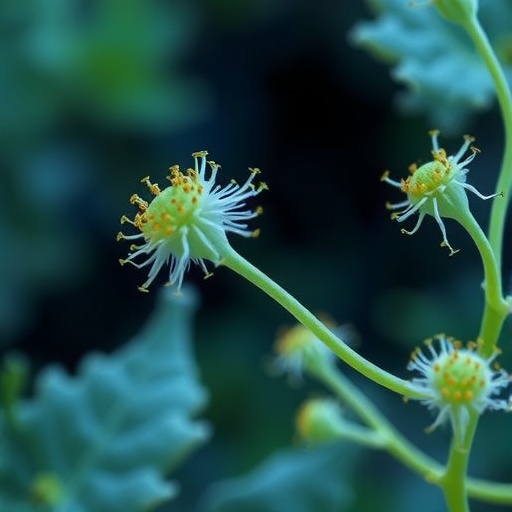
In a groundbreaking study published in Nature Microbiology, a team of researchers has unveiled an intricate cooperative strategy employed by Pseudomonas syringae subpopulations during the infection of plant hosts. This new insight sheds light on the sophisticated spatial and temporal coordination of bacterial motility and secretion systems that underpin successful colonization and virulence. The findings significantly advance our understanding of how bacterial communities optimize their infection strategies through inter-subpopulation communication, adding a novel layer of complexity to plant-pathogen interactions.
Pseudomonas syringae is a notorious phytopathogen responsible for a wide array of diseases affecting a multitude of economically important crops worldwide. Its capability to invade plant tissues and subvert immune responses results in significant agricultural losses annually, making it a critical subject of microbiological and plant pathology research. Despite extensive study, the precise mechanistic details of how heterogeneous bacterial populations orchestrate their attack remain elusive — until now.
The study reveals that P. syringae populations are not homogenous but instead consist of specialized subpopulations that act in concert by finely tuning their flagellar motility and type III secretion system (T3SS) deployment over time and space. Flagella play a pivotal role in bacterial movement, allowing cells to navigate towards favorable niches within the plant host, whereas the T3SS serves as a molecular syringe, injecting effector proteins that manipulate plant cellular processes to the pathogen’s advantage.
By applying advanced live-cell imaging techniques combined with quantitative spatial profiling, López-Pagán et al. demonstrated that distinct subpopulations within a single P. syringae colony adopt complementary functional roles. One subpopulation exhibits hypermotility driven by enhanced flagellar activity to pioneer entry points on the plant leaf surface. Meanwhile, other subpopulations activate their T3SS machinery at precise moments once proximity to plant cells is established, facilitating the injection of virulence factors while minimizing premature immune detection.
This elegant cooperation is not static but dynamically regulated, with bacterial cells continually assessing their microenvironment and modulating their behavior accordingly. Temporal synchrony was shown to be critical: the initial flagellar-driven invasion phase creates conditions that enable subsequent T3SS activation in neighboring cells. The researchers mapped this sequence using time-resolved fluorescence microscopy, capturing a spatiotemporal cascade of bacterial actions.
Importantly, the work underscores how spatial segregation within bacterial communities enhances overall virulence. Subpopulations form microdomains on the leaf surface that segregate motile and secretory tasks, preventing functional interference and maximizing pathogenic efficacy. This division of labor mimics multicellular organisms’ tissue specialization, illustrating an advanced level of microbial social behavior.
On a molecular level, the switch between motility and secretion states involves a complex regulatory network integrating environmental cues, quorum sensing signals, and intracellular feedback loops. Transcriptomic analyses revealed distinct gene expression patterns corresponding to the functional states of each subpopulation. Genes encoding flagellar components were highly expressed in the invading cells, while those for T3SS apparatus and effectors surged in cells poised for direct host interaction.
The research also highlights the role of spatial gradients in nutrients and plant surface compounds, which guide bacterial subpopulations toward appropriate functional states. This suggests that P. syringae has evolved mechanisms to decode host-derived chemical signals, coordinating its infection machinery with remarkable precision.
Beyond fundamental microbiology, these findings carry profound implications for agricultural disease management. Targeting the temporal coordination between motility and secretion systems may disrupt the infection process at multiple stages simultaneously, offering a novel strategy for controlling P. syringae-mediated crop diseases. Furthermore, understanding the cooperative dynamics within bacterial populations opens avenues for developing anti-virulence therapies that inhibit bacterial community functions rather than kill bacteria outright, potentially reducing resistance development.
The study employed state-of-the-art genetic tools to fluorescently label flagellar structures and T3SS components, allowing visualization of their distribution and dynamics at single-cell resolution in planta. Coupling these observations with mutant analyses confirmed that disrupting either flagellar function or T3SS timing substantially diminished infection success, validating the critical nature of their coordinated deployment.
This work exemplifies a shift from viewing bacterial pathogenesis as a consequence of individual cell behavior toward appreciating the complexity of bacterial communities acting as integrated units. It also raises intriguing questions regarding the evolutionary pressures that shaped such cooperative dynamics and how widespread similar mechanisms might be among other plant and animal pathogens.
Looking ahead, the authors propose expanding their research to explore interspecies interactions within the plant microbiome and how such collaborations or competitions influence P. syringae infection strategies. Insights gleaned could unveil broader principles of microbial ecology and inform holistic approaches to plant health management.
In sum, this landmark study offers compelling evidence that Pseudomonas syringae subpopulations synchronize their flagellar motility and type III secretion activities in space and time to optimize host colonization. This discovery not only enriches our molecular understanding of bacterial pathogenicity but also sets the stage for innovative interventions that disrupt these finely tuned cooperative behaviors, promising strides towards more sustainable crop protection.
Subject of Research:
Mechanisms of cooperation among Pseudomonas syringae subpopulations involving coordinated flagellar motility and type III secretion dynamics during plant infection.
Article Title:
Pseudomonas syringae subpopulations cooperate by coordinating flagellar and type III secretion spatiotemporal dynamics to facilitate plant infection.
Article References:
López-Pagán, N., Rufián, J.S., Luneau, J. et al. Pseudomonas syringae subpopulations cooperate by coordinating flagellar and type III secretion spatiotemporal dynamics to facilitate plant infection. Nat Microbiol 10, 958–972 (2025). https://doi.org/10.1038/s41564-025-01966-0
Image Credits:
AI Generated
DOI:
https://doi.org/10.1038/s41564-025-01966-0
Tags: agricultural disease managementbacterial community dynamicsbacterial motility coordinationcrop disease prevention strategieseconomic impact of plant diseasesinter-species bacterial cooperationmechanisms of plant tissue invasionphytopathogen virulence mechanismsplant-pathogen interactionsPseudomonas syringae infection strategiessubpopulation communication in microbestype III secretion system in bacteria





